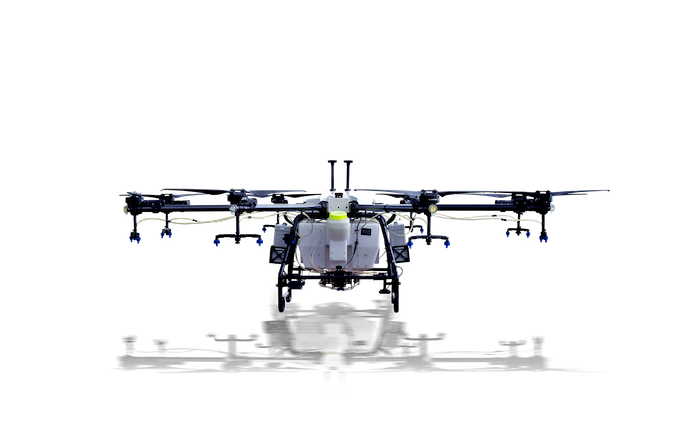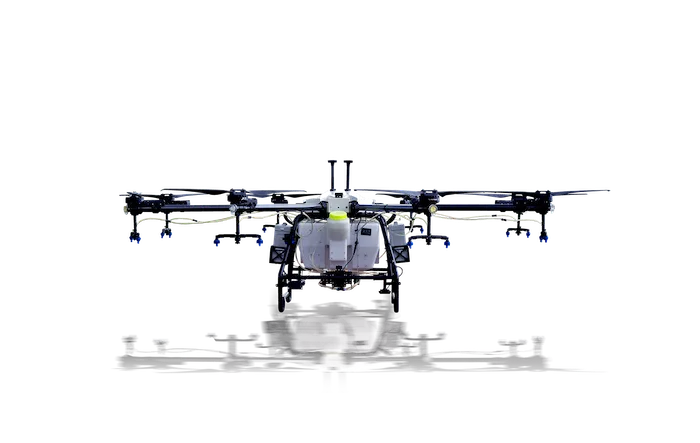The future of agricultural drone use in the U.S. became brighter when the Federal Aviation Administration recently granted Texas-based drone builder Hylio a regulatory exemption that will allow it to swarm its heavy-lift drones with only one operator in control. The change in rules also promises expanded use of unmanned aerial vehicles (UAVs) beyond agriculture’s early adopters.
Hylio co-founder and CEO Arthur Erickson says the development was a case of regulations catching up with existing technology and promises a 3-fold increase in productivity for drone operators applying material to agriculture crops, plus a significant reduction in their labor requirements.
“Until this exemption, only 1 drone could be flown per pilot, and if the drone weighed more than 55 pounds — and most crop input drones are in the 300-500-pound range — a visual observer was also required to be on-site of the flight operation,” Erickson says. “If you had 3 drones flying, you would need 6 people on site, which is counter to the entire logic of drones to reduce labor.
“The law finally caught up to the logic and existing technology of unmanned aerial vehicles used to apply materials to cropland. 1 person can now operate 3 drones in a swarm, each doing 50 acres per hour, so that represents a 3-times boost in productivity.”

BETTER COVERAGE. Hylio’s AG-272 sprayer drone can cover up to 50 acres per hour at a 2 gallon per acre application rate. With the new change to FAA regulation, 1 operator can fly 3 of these drones at once, a 3-fold increase in productivity. Photo Credit: Hylio
Erickson adds current technology can swarm 4 UAVs, but the exemption specifies only a trio to be used. He welcomes the new regulatory exemption for Hylio’s crop-input drones. The company applied for the exemption to the FAA’s Rule 107 over a year ago and has eagerly awaited the outcome for U.S. operations.
“It’s been legal to swarm large drones in Brazil and some Asian countries for some time, but not in the U.S.,” he says. “The FAA does good work, and we were happy that administrators there put a priority on this regulatory move.”
Currently the exemption applies only to Hylio and its products, but Erickson says the FAA will soon codify a general set of requirements to include other manufacturers of such drones. He says those requirements likely will include specifications for what is in operating manuals, including language addressing emergency operations and procedures, and stipulations to apply to a broad range of manufacturer’s drones.
1 person can now operate 3 drones in a swarm, each doing 50 acres per hour…
“We’re hopeful to have a summary grant of this exemption in time for folks to be flying under its authorization within weeks,” Erickson says. “We’re the company that first received the exemption, so our several hundred users will be first in the field, but by summer, other manufacturers like DJI also could be swarming drones under the exemption after they tweak their procedures, manuals and equipment to comply.”
Beyond Early Adopters
Erickson says current on-farm UAV use consists largely of early adopters in agriculture, but now that technology and regulations are aligned to break the 150-acre per hour productivity limit with drones as aerial applicators, drones are a viable alternative to self-propelled ground rigs and even some helicopters.
“Now that the productivity of drone-applied products has become more competitive with swarm deployments, you’re going to see many co-ops, equipment dealers, aerial application businesses, and even individual growers paying a lot more attention to UAVs as viable tools,” Erickson says. “This is particularly true when farmers realize the increased timing flexibility that drones provide for needed field operations when soil conditions don’t allow ground rigs in the field.”
Drones also don’t cause compaction, giving them an advantage over ground rigs. Erickson says large nationwide service companies are now paying more attention to application UAVs.
“These companies are making hundreds of millions of revenue a year, and they needed to see actual productivity beyond the fact that drones can apply payloads,” he says. “With our economically viable ability to swarm drones at the 150-acre per hour rate, we’ve caught their attention.”
Erickson says Hylio will continue serving its current customer base of small- to medium-size farmers, but it will also gear up to meet the needs of the larger corporate enterprises. Another market avenue is through traditional OEM farm equipment dealers.
“We’re currently working with some CNH and John Deere dealers to resell our drones, particularly where those dealers are not bound to strict company-line product inventory,” Erickson says. “It’s already happening. There’s a ton of interest.”
A Heavier Future
While Erickson sees continued development of larger drones for agricultural use, he says there’s a theoretical practical upper limit at which deployment of multiple smaller drones is economically more feasible.
Currently Hylio’s products are capable of roughly 20 gallons of payload, and future products could range from 30-50 gallons.
“At that size, you’ll have 2 or 3 50-gallon UAVs being deployed, so I think we’re going to see capping out that ceiling of size there,” he says.
Related Content:
CNH Takes Minority Investment in Drone Imaging AI Company Bem Agro
2024 National Farm Machinery Show: New Drones, Aftermarket Kits, Combine Technology & More
[Technology Corner] Ecorobotix ARA Precision Sprayer Scans Field in Less Than 250 Milliseconds




![[Technology Corner] Autonomy & Robotics Take Center Stage](https://www.precisionfarmingdealer.com/ext/resources/2026/01/12/Autonomy--Robotics-Take-Center-Stage.webp?height=290&t=1768253759&width=400)


